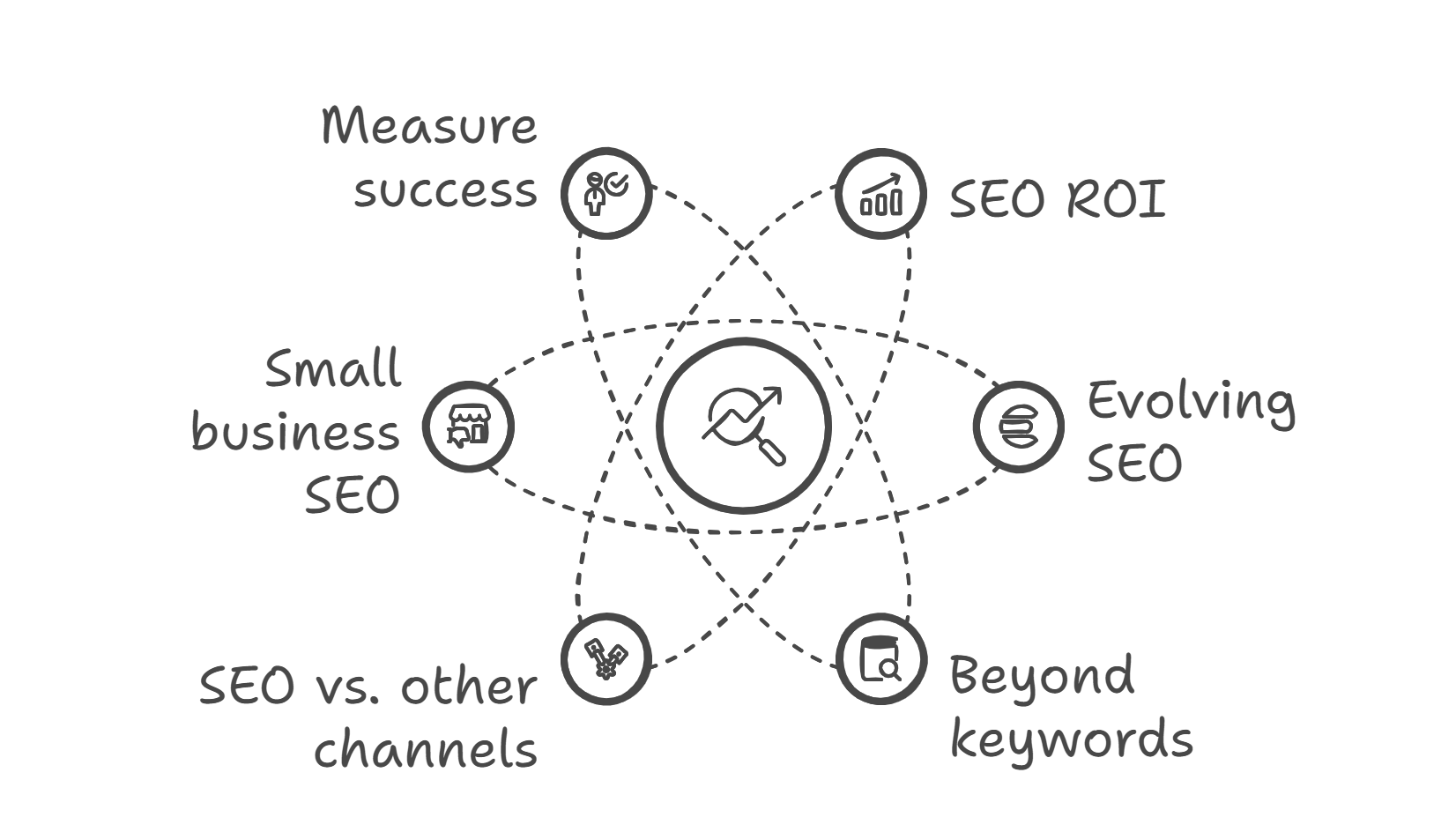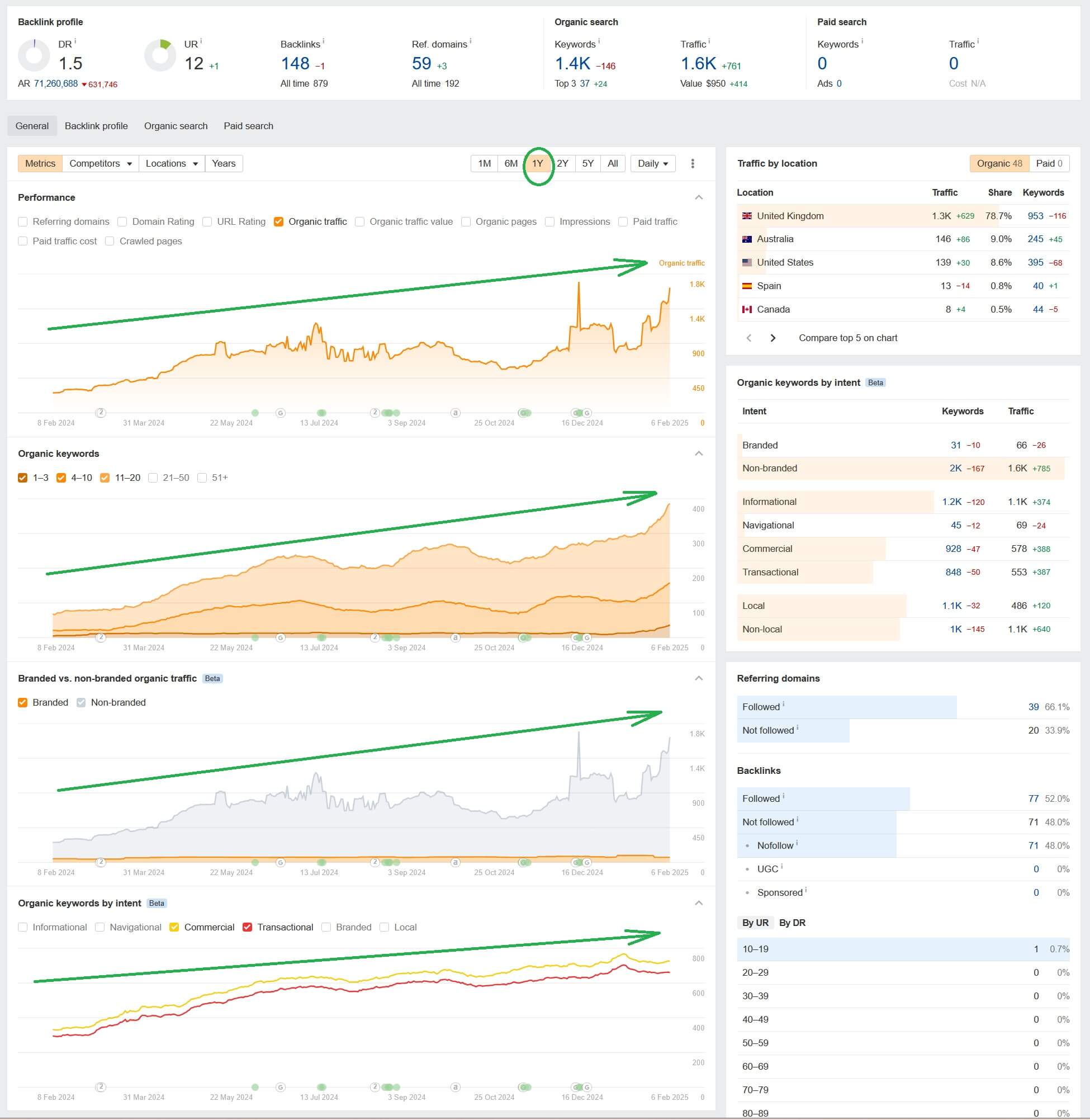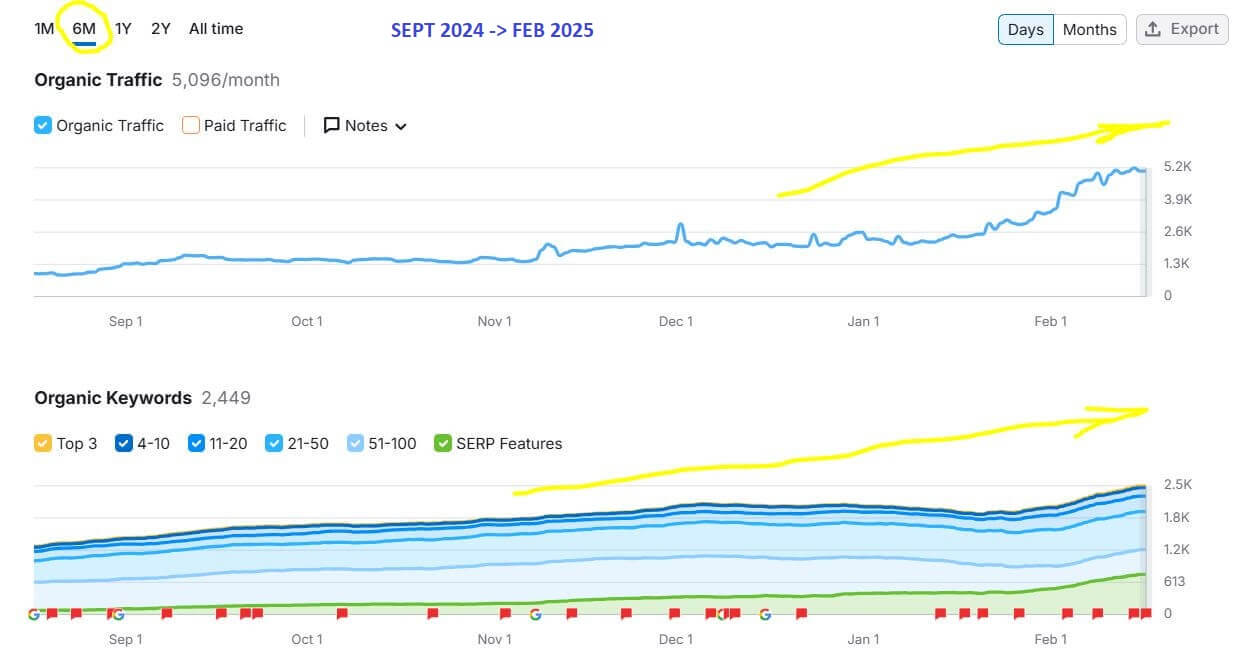Over the past decade, I’ve worked with companies across industries, and one question I hear time and time again is: “Is SEO still a good investment?”
This debate has only intensified in recent years. With Google’s AI-driven updates, the rise of zero-click searches, and the growing competition for rankings, some businesses wonder if SEO is still viable – or if paid ads and social media are better alternatives.
I’ve studied this closely, and the truth is that SEO is more valuable than ever – but only if done right. The strategies that worked five years ago won’t cut it anymore. Google isn’t just ranking websites; it’s curating the search experience, and only those who truly provide value are rewarded.
Through my own Google Search Console (GSC) reports, I’ve seen how low-quality, thin content isn’t just dropping in rankings – it’s disappearing from search results entirely. Some pages that once sat on page five have now lost all impressions, meaning Google has decided they don’t deserve to be shown at all.
My analysis reveals that large, well-known websites lose significant traffic overnight due to Google’s November 2024 Core Update. These weren’t small ranking drops – entire sections of their sites vanished from organic search because they failed to deliver real value or relied on outdated SEO tactics.
So, is SEO dead? No. But SEO has changed dramatically, and only those who adapt will continue to benefit.
In many cases, the content wasn’t created to serve users but simply to sell backlinks or manipulate rankings, which Google has become increasingly aggressive in penalising. When search engines detect that content exists purely for SEO manipulation rather than providing genuine insights or solving user problems, it’s only a matter of time before it stops ranking altogether.
So, is SEO still worth it? Yes, but only for those willing to adapt. In this article, I’ll break down what’s changed, what works, and whether SEO is the right investment for your business in 2025.

The real value of SEO (why it still matters in 2025)
SEO vs. other marketing channels: What the data shows
Some business owners debate whether SEO is still relevant when compared to paid search (PPC), social media, or influencer marketing. When looking at the data, SEO remains one of the most cost-effective strategies in the long run.
- Organic search still accounts for over 50% of total website traffic across most industries.
- Studies show that SEO delivers an average ROI of 5-12x the initial investment, whereas PPC typically generates 2-4x ROI but stops as soon as ad spend ends.
- 75% of users scroll past paid ads and click on organic results instead.
I’ve worked with businesses that spent tens of thousands on Google Ads every month, only to realise that the moment they stopped paying – or when Google blocked their Ads account – their traffic disappeared overnight. SEO, on the other hand, continues driving traffic long after the initial investment, making it a more sustainable long-term strategy.
But what happens when you apply SEO without a massive budget, expensive ads, or questionable link-building tactics?
SEO still works: A real-world organic growth case study (2024-2025)
Take a look at the real-world SEO performance of a website I’ve worked on in my spare time – a side project I handle on weekends and evenings outside of my full-time job. Despite being a side hustle, organic traffic, top-ranking keywords, and high-value commercial and transactional queries have consistently grown throughout 2024 and into 2025.
No dodgy backlinks, no black-hat tactics – just:
✔ Targeting the right content for the right audience
✔ Solving critical technical SEO issues
✔ Focusing on search intent and user experience
Ahrefs Organic Growth Report (2024-2025):

The company reports that these rankings are translating into valuable leads and new customers from multiple countries, proving that SEO isn’t just about rankings – it’s about attracting the right audience and driving conversions.
And remember, this isn’t a massive corporation with a multi-million marketing budget – it’s simply SEO done properly, focused on solving user needs and building long-term search visibility.
This case study proves what I’ve seen time and time again: SEO is still one of the most effective ways to generate sustainable business growth.
SEO in 2025: more than just ranking keywords
I’ve seen many website owners still approach SEO as if it’s just about ranking for specific keywords – but that strategy no longer works on its own.
Search engines have evolved to focus on user intent, not just keyword density. Data indicates that businesses achieve massive ranking boosts simply by:
- Creating highly useful, structured content that directly answers user queries.
- Optimising for UX signals, such as page speed, engagement, and mobile-friendliness.
- Becoming authorities in their niche, rather than trying to game the system with keyword stuffing or shallow content.
The websites that saw positive ranking shifts after the November 2024 update weren’t those with the most backlinks or perfect keyword optimisation – they were the ones providing genuine value to users. They also focused on a specific niche where they had real expertise, rather than trying to cover broad, unrelated topics simply to increase traffic.

Debunking SEO myths: what businesses get wrong
“SEO is free” – the real cost of doing it right
A common myth is that SEO is free because you’re not paying for clicks. In reality, SEO is either a time investment, a financial investment, or both.
- If you do SEO yourself, expect to spend hours on keyword research, content creation, technical fixes, and link building.
- If you hire an expert or an agency, expect costs ranging from £1,500 to £5,000 per month, with high-level strategies costing £10,000+ for competitive industries.
The real cost isn’t just money – it’s patience. Companies that commit to SEO properly see long-term rewards, while those looking for quick wins often end up frustrated.
“SEO takes too long” – what realistic timelines look like
I’ve worked with clients who expected instant SEO results (checking Semrush, Ahrefs, Google Search Console and the Bing Webmaster Tools daily!) and were disappointed when they didn’t see traffic growth within weeks. But SEO isn’t designed for immediate gratification – it’s about building an asset.
- Most businesses start seeing organic traffic growth in 3-6 months.
- Significant ranking shifts typically happen within 6-12 months.
- Once SEO is working, it continues driving traffic indefinitely without additional ad spend.
Paid ads stop delivering traffic the moment you stop paying. In contrast, SEO keeps generating leads, month after month.
Think of SEO like building equity in a home – it appreciates over time, whereas PPC is like renting – the moment you stop paying, your traffic disappears.
“SEO is Dead” – Why it’s actually more important than ever
When Google released the November 2024 Core Update, I noticed a lot of website owners panicking. Some even claimed “SEO is dead” because their rankings tanked.
But what I saw was a shift in priorities – Google is rewarding businesses that focus on real expertise, trust, and value rather than keyword stuffing or outdated tactics.
The businesses that invested in high-quality content, fast-loading websites, and genuine expertise actually saw ranking boosts after the update.
SEO isn’t dead-it’s just more competitive. If you’re doing it right, Google updates actually work in your favour.
Google’s November 2024 Core Update shook the SEO world, causing major ranking fluctuations. Many big-name websites lost traffic overnight – not because SEO stopped working, but due to outdated tactics and low-value content. In my own Google Search Console reports, I’ve seen thin pages vanish completely in October and November 2024, losing all impressions.
Google isn’t just shifting rankings – it’s deciding what deserves to be indexed. If you want to stay ahead, I’ve broken down the key changes and what they mean for SEO in this guide on Google’s November 2024 Core Update.
SEO vs. other marketing strategies: When SEO wins and when it doesn’t
SEO vs. PPC (Google Ads)
| Factor | SEO | PPC (Google Ads) |
|---|---|---|
| Cost | Higher upfront, but lower long-term costs | Continuous ad spend required |
| Time to results | 3-6 months | Immediate |
| Sustainability | Long-term traffic growth | Stops when budget ends |
| Trust factor | Higher (users trust organic results more) | Lower (ads seen as promotional) |
While PPC is great for quick wins, I’ve seen businesses waste thousands on ads without ever building sustainable traffic. SEO requires patience, but its long-term ROI is often much higher.

SEO vs. Social media marketing: What converts better?
Social media drives brand awareness, but it’s not as effective for conversion-focused traffic.
- Social media users are in browsing mode, while search users are in buying mode.
- SEO drives targeted traffic from high-intent searches, whereas social media traffic is less predictable.
- Social media engagement is fleeting, while SEO traffic is evergreen (content from 3 years ago can still drive traffic – In fact, I have untouched content from as far back as 2014-2015 that’s still getting organic traffic for one of my websites.).
Key takeaway: Social media builds brand presence, but SEO consistently brings in high-intent traffic that converts into leads and sales.
A well-structured SEO strategy doesn’t just help with rankings – it’s one of the most powerful tools for brand visibility and recognition. While social media provides short-term engagement and viral potential, SEO helps establish a consistent presence in search results, ensuring that your business is visible to high-intent users over time.
Brands that invest in SEO become industry leaders, as they dominate search rankings, featured snippets, and knowledge panels. But achieving this requires more than just basic optimisation – it involves content authority, link-building strategies, and technical excellence.
If you want to amplify your brand’s online presence through SEO, I’ve outlined some of the most effective techniques in this guide: SEO techniques to amplify brand visibility and recognition.
SEO vs. Email marketing: The long-term impact
Email marketing is fantastic for nurturing leads, but it relies on SEO (or paid ads) to build an email list in the first place.
- SEO helps you capture new leads, while email marketing helps you convert and retain them.
- Email has higher conversion rates, but SEO brings in fresh potential customers.
Key takeaway: SEO and email marketing work best together – SEO attracts, and email converts.
Many businesses underestimate the power of SEO-driven content marketing, often assuming that blogs are just for thought leadership or brand awareness. But from what I’ve seen, blogs can be one of the most effective business tools for long-term traffic and lead generation – when structured correctly.
Instead of chasing viral trends or publishing generic content, a strong SEO-driven blog strategy focuses on:
- High-intent keywords – Writing content that aligns with what potential customers are actually searching for.
- Evergreen topics – Creating valuable content that remains relevant long after publication.
- Search-optimised structure – Ensuring on-page SEO best practices help content rank over time.
I’ve worked with brands that saw significant traffic and revenue growth simply by structuring their blogs around SEO principles. If you want to turn your blog into a business tool that consistently drives traffic and leads, I’ve detailed the best SEO content writing ideas and strategies in this guide: Turn blogs into business tools: top content writing ideas.
While paid search, social media, and email marketing all play an important role, SEO is the foundation that keeps bringing in sustainable, high-intent traffic without continuous ad spend.
The smartest strategy? Use SEO as a long-term foundation, PPC for immediate visibility, social media for branding, and email to nurture leads.
Is SEO worth it for small businesses?
Small business owners often assume that SEO is only valuable for large corporations with massive marketing budgets. But from what I’ve seen, small businesses can often gain even more from SEO than their bigger competitors – especially when they target local search and high-intent keywords strategically.
SEO on a budget: cost-effective strategies for small businesses
Unlike large brands that can afford to throw money at paid ads and multiple marketing channels, small businesses need to be smart and selective with their SEO investments. I’ve worked with businesses that outperformed much bigger competitors simply by focusing on what matters most:
- Local SEO: Targeting location-based searches, optimising Google My Business, and encouraging customer reviews.
- Long-tail keywords: Going after specific, lower-competition keywords that bring in highly relevant traffic.
- High-converting content: Creating blog posts, service pages, and FAQs that directly answer what potential customers are searching for.
- Technical SEO basics: Ensuring the website loads quickly, is mobile-friendly, and is properly structured for search engines.
When done right, SEO delivers results that paid ads can’t match – it keeps working even when you’re not actively spending.
Is local SEO enough?
Local SEO is one of the most powerful tools for small businesses, but on its own, it may not be enough – especially for businesses looking to expand their reach beyond their immediate area.
Google My Business (GMB) plays a huge role in local search visibility, but I’ve also seen small companies struggle when they rely too heavily on it. If Google changes its local ranking algorithm or a competitor gets more reviews and citations, your visibility can drop overnight.
That’s why a hybrid approach works best – leveraging local SEO while also investing in organic search strategies that bring in traffic from beyond just map listings.
Why small businesses can’t afford to ignore SEO
Case studies demonstrate that small businesses triple their customer base by investing in SEO, while others who ignored it were left relying on word-of-mouth and unpredictable referrals.
However, SEO alone isn’t always enough. Converting visitors into paying customers requires optimising your website for conversions (CRO) – ensuring that traffic isn’t just landing on your site but taking meaningful actions.
If you want to learn more about how SEO and CRO work together to drive business success, I’ve outlined the best strategies in this detailed guide: How SEO and CRO work together for business success.
The financial side: How to measure SEO success
One of the biggest mistakes I’ve seen businesses make is focusing only on rankings and traffic while ignoring the real metrics that indicate success.
In reality, SEO is about much more than just getting more visitors – it’s about attracting the right audience and turning them into customers. Tracking performance correctly is crucial, yet many businesses fail to measure beyond vanity metrics like clicks and impressions.
If you want to ensure your SEO efforts are truly paying off, you need to monitor key performance indicators such as conversion rates, customer lifetime value (CLV), and revenue generated from organic traffic. I’ve broken down these critical SEO metrics in detail in this article on how to track, analyse, and optimise your search performance.

However, collecting data is only half the battle – what really matters is knowing how to interpret it. Many businesses focus too much on rankings and traffic volume without understanding why certain pages perform better than others, where conversions are coming from, and how user behaviour influences success. Without proper analysis, it’s easy to waste resources on the wrong strategies.
To help businesses make sense of their SEO performance, I’ve put together a detailed guide on how to analyse and interpret SEO data for reporting success, covering key insights on what to track and how to make data-driven decisions: How to interpret and analyse SEO data for reporting success.
How to calculate SEO ROI
To determine whether SEO is worth the investment, I always recommend using this simple formula:
SEO ROI = (Revenue from SEO – SEO Investment) ÷ SEO Investment x 100
For example, if you:
- Invest £3,000 over six months
- Generate £15,000 in additional profit (not revenue!) from organic search
- Your ROI is 400%
This is why SEO isn’t an expense – it’s an investment in long-term growth.
Over the years, I’ve noticed a significant shift in how businesses approach SEO investments. It’s no longer just about hiring a generalist to tweak a few keywords – it requires specialised roles and expertise to truly maximise SEO’s ROI.
In 2025, SEO professionals play a much more strategic role, covering areas like:
- Technical SEO – Ensuring websites meet Google’s evolving technical requirements.
- Content optimisation – Structuring content for search intent and conversion.
- Digital PR & link building – Earning high-quality backlinks from authoritative sources.
- AI-driven search strategies – Adapting to Google’s AI-generated search results.
The days of having just an “SEO guy” are over – companies build entire teams or hire specialists to ensure long-term success. However, considering the rapid evolution of AI tools and virtual assistants, I believe many of these roles could soon be replaced or significantly altered by automation. Understanding the different SEO roles and their contributions is crucial if you want to make the smartest investment in your SEO strategy.
To help businesses understand what kind of SEO expertise they need, I’ve broken down the top SEO job titles and responsibilities for 2025 in this guide: Top SEO job titles and responsibilities in 2025.
Final thoughts: Is SEO worth it?
From my research, personal experience, and real-world case studies, I can confidently say:
SEO is still one of the most valuable digital marketing strategies in 2025 – but only if done correctly.
If you’re considering investing in SEO, here’s my advice:
- If you need immediate traffic, PPC may be the better option.
- If you want sustainable, long-term growth, SEO is the best investment.
- If you combine SEO with strong content, UX, and authority-building, you’ll see exponential results.
I’ve seen businesses double or triple their organic traffic by focusing on SEO the right way, while others vanished from search results because they relied on outdated tactics.
SEO isn’t for everyone, but for those who commit to doing it properly, the rewards are undeniable.